Laringe
La laringe, detta anche scatola vocale, è un organo della parte anteriore del collo coinvolto nella respirazione, nella fonazione e nella protezione della trachea. Le corde vocali sono alloggiate all’interno della laringe. La laringe collega la parte inferiore della faringe con la trachea.
Di seguito sono riportate le immagini di una laringe normale, offerte come punto di confronto per tutti gli esempi di malattie e disturbi laringei altrove su Laryngopedia. Si possono ragionevolmente chiamare le corde vocali “labbra laringee”. Pensando alle labbra di un trombettista come ad un’analogia, lui o lei le separa per prendere fiato, e poi le pizzica insieme per “ronziare” nel bocchino della tromba.
Allo stesso modo, le labbra laringee si separano per respirare, anche se in un’apertura a forma di V, e poi si premono insieme in una linea per “ronziare” nel tratto vocale. Si potrebbe quasi suonare la tromba usando le labbra laringee!
Foto della Laringe
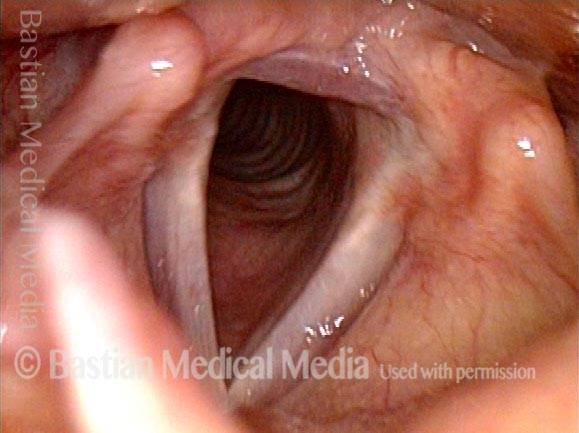
Laringe: posizione di respirazione (1 di 2)
Laringe normale con corde vocali in posizione abdotta e di respirazione. Questa è una vista dall’alto, guardando in linea con la trachea oltre le corde vocali.

Laringe: posizione fonatoria (2 di 2)
Laringe normale con corde in posizione addotta, fonatoria (voicing). Luce continua. Notare la corrispondenza dritta delle corde e lo stretto spazio fisiologico tra le corde nell’istante prefonatorio, appena prima della sfocatura vibratoria.
Colorazione con Nicotina di una Laringe Danneggiata

Fumatore accanito (1 di 2)
Grave ispessimento diffuso, secchezza e irregolarità di tutte le aree della laringe in un forte fumatore.

Vista più ravvicinata (2 di 2)
In questa visione più ravvicinata, il colore marrone dorato sulle corde vocali è una macchia di “catrame e nicotina”. In una laringe più umida e liscia, la coltre di muco tende a “scorrere” per impedire la comparsa della macchia. Questa laringe fornisce una rappresentazione visiva di ciò che è nel fumo di sigaretta.
Effetti dell’Intonazione sulla Lunghezza delle Corde Vocali e sull’Ampiezza Vibratoria
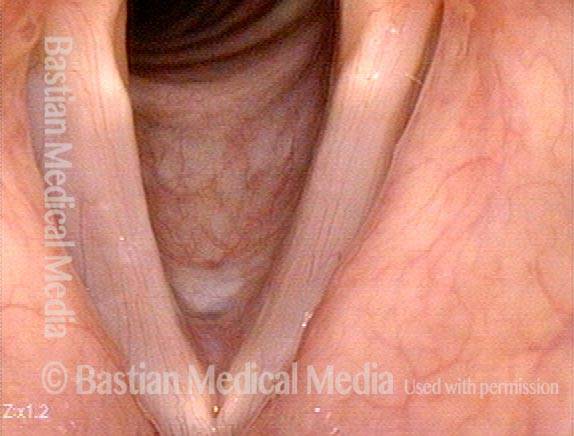
Posizione di respirazione abdotta (1 di 10)
Corde vocali rapite (separate) durante la respirazione.
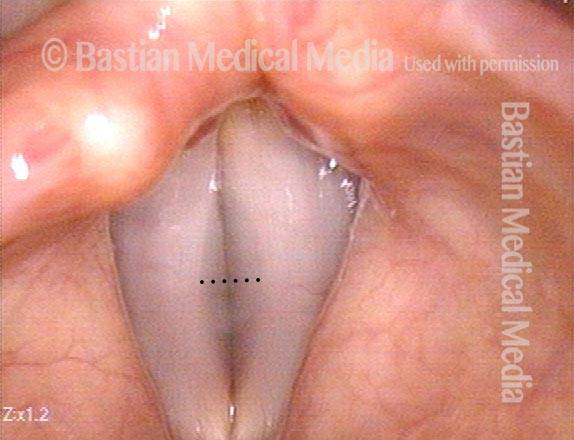
Offuscamento fonatorio (2 di 10)
Produzione di voce con luce standard a G2 (~98 Hz), che mostra la sfocatura dei margini ßà dovuta a 98 vibrazioni al secondo! Pizzica un elastico a bassa tensione per un’analogia visiva.

Fonazione (3 di 10)
Sonorizzazione, ma ora a un tono quasi 2 ottave più alto, E4 (~330 Hz). Le corde vocali sono allungate in lunghezza (più lunghe) e l’ampiezza vibratoria molto minore, e questo spiega la sfocatura più stretta. Vedere anche le foto 7 e 8. Allungare e quindi pizzicare lo stesso elastico per un’analogia visiva.

Fase aperta, A2 (4 di 10)
Sotto la luce stroboscopica, la fase aperta della vibrazione, utilizzando una produzione affannosa e poco energizzata per aumentare l’ampiezza (distanza percorsa lateralmente) della vibrazione.

Fase chiusa, A2 (5 di 10)
Fase chiusa di vibrazione in A2 (~110 Hz).

Fase aperta, voce ferma (6 di 10)
Fase aperta di vibrazione utilizzando una produzione vocale decisa; ciò riduce l’ampiezza della vibrazione rispetto alla Foto 4, anche se l’altezza è la stessa di quella foto.

Fase chiusa, E4 (7 di 10)
Fase chiusa di vibrazione a E4 (~330 Hz).
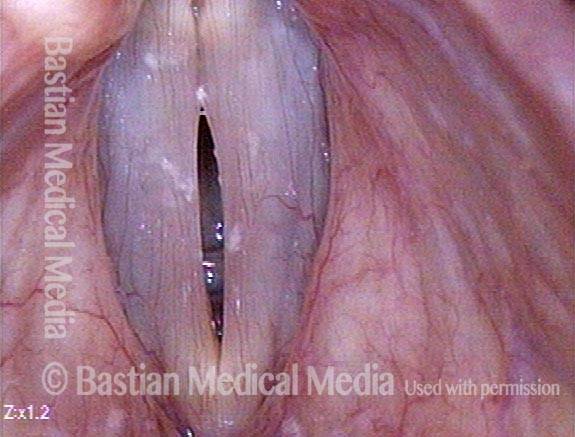
Fase aperta, E4 (8 di 10)
Fase aperta anche in E4, che mostra un’ampiezza di vibrazione minore e spiega perché la sfocatura del margine grigio visibile nella foto 3 è “stretta” rispetto a quando l’ampiezza vibratoria è maggiore.

Fase chiusa, A4 (9 di 10)
Fase chiusa di vibrazione a La4 (~440 Hz). Le corde vocali si allungano per creare un tono alto (confrontare in particolare con la foto 5).
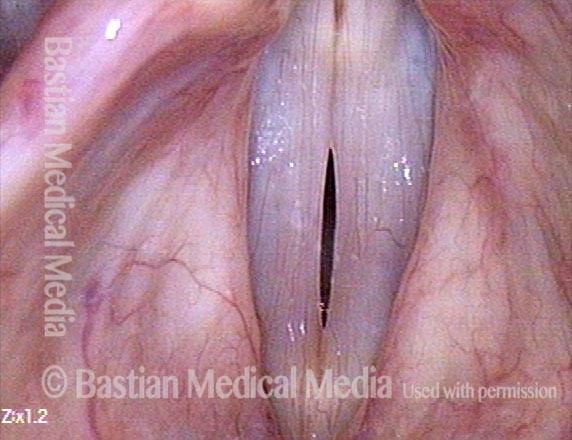
Fase aperta, A4 (10 di 10)
Vibrazione in fase aperta anche in A4. L’ampiezza a questo tono alto è inferiore a quella di E4 (foto 8) e sicuramente a quella di A2 (foto 6). Notare che l’ampiezza della vibrazione è alterata dal volume e non solo dal tono.
La Laringe Astenica ma Normale
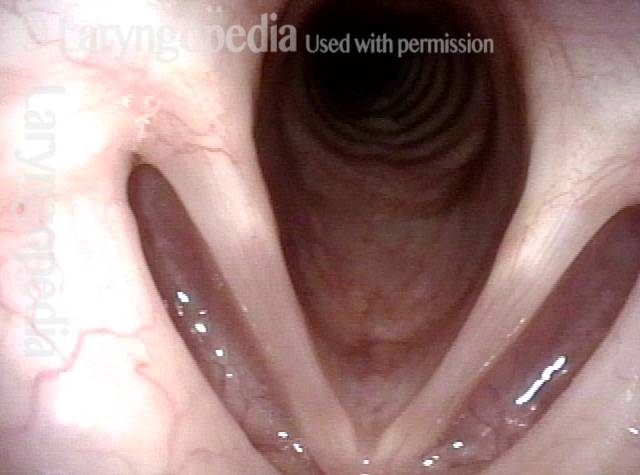
Laringe astenica (1 di 6)
Questa adolescente tranquilla e pacata è stata esaminata per un motivo diverso dalla sua voce. In via incidentale, la sua è un buon esempio di laringe astenica. I risultati dettagliati sono descritti nella Foto 2.

Corde vocali sottili (2 di 6)
Vista più ravvicinata sotto luce a banda stretta. Notare quanto sono sottili le sue corde vocali. I ventricoli sono capienti. Non c’è massa “conica” sotto i margini delle corde vocali.

Prefonatorio istante (3 di 6)
All’istante prefonatorio per G5 (784 Hz), luce standard. Notare lo spazio significativo tra le corde, ma non dovuto a MTD, in quanto le corde posteriori sono completamente addotte.

Vista fonatoria (4 di 6)
Anche nel G5 la vibrazione offusca i margini.

Luce stroboscopica (5 di 6)
Sotto luce stroboscopica a F5 (698 Hz). Le corde vocali posteriori rimangono unite.

Fase chiusa (6 di 6)
Ancora a F5, ma la fase chiusa della vibrazione non è completamente chiusa.
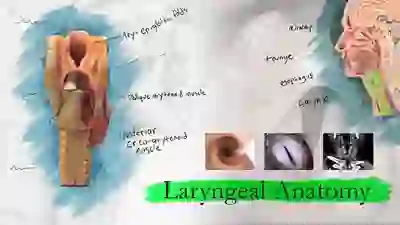
Introduzione all’anatomia della laringe, della faringe e delle vie aeree
In questa presentazione il Dott. Bastian fornisce un’introduzione all’anatomia della laringe, della faringe e delle vie aeree. Questo video può aiutare le persone a comprendere altro materiale presente su questo sito web.